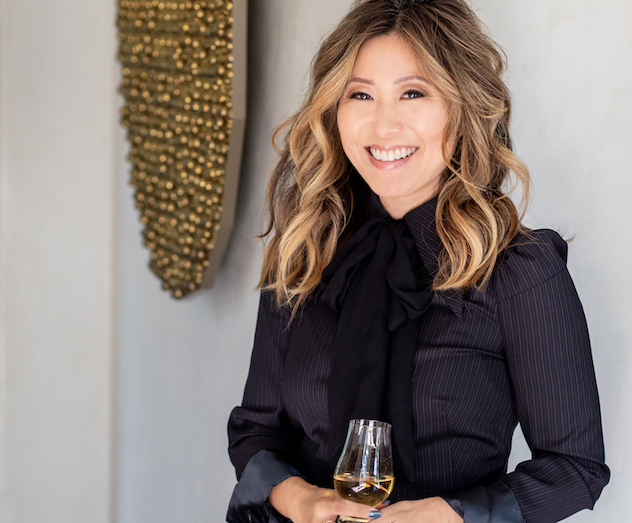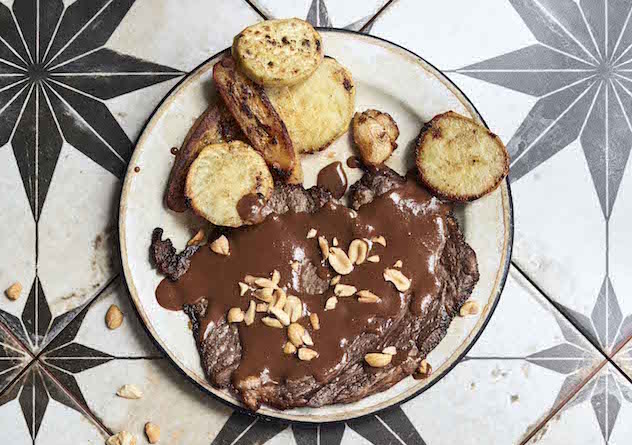Ann Soh Woods is the founder of Kikori, one of the first Japanese rice whiskeys — that’s whiskey with an e, owing to it being produced for the American market — introduced to the U.S.
The crisp, light, single-grain whiskey is based in Los Angeles but made in Kyushu, Japan. It launched in 2015. Last year, Woods released another spirit, the yuzu liqueur Yuzuri.
Woods, who is Korean American, comes from a marketing and branding background and had no prior experience in the spirits industry or in entrepreneurship when she started Kikori. The idea was simple: Make an accessible whiskey that can be enjoyed at any time of the day.
That idea eventually grew into a buzzy, widely found bottle that’s found its place on prominent menus like Nobu’s, and inside homes as a versatile liquor for mixing or enjoying by itself.
How did it all begin?
A lot of time on the way to visiting Korea, my family would stop in Japan because there were no non-stop flights. I like to say my passion started with Hello Kitty — my taste matured and eventually it was about food, spirits, culture and hospitality. My husband and I would go back and forth quite often because of his work, and I loved their whisky and their spirits. Then I noticed that we didn’t really have anything like it in the U.S. I thought, “Why don’t I make something that I would drink?” It sounded pretty easy — but I had no experience whatsoever. It ended up being, I learned from the beginning as an outsider.
What was the first step?
We had to find a distiller in Japan who would work with us. People like to ask, “Was it difficult because you are a woman?” Well, I think it’s just hard, period. [Japanese spirits] is a culture that’s not used to opening up to foreigners and working with them. But we did find one. It’s a great partnership. It’s all about building trust and loyalty by spending the time to understand each other.
Was it difficult to make them try to understand you wanted to make a product for America?
Yes. One, they really didn’t think it would work! They thought the U.S. palate was very different. I said, we’ll use my palate — I made this for myself, basically! When I think they really turned a corner was when we started showing them some of the branding, which is traditional, but a little more modern. We bridged both aspects of something still very Japanese, but something contemporary too.
What is your personal relationship with spirits?
My parents are immigrants. We grew up with a lot of whiskey in the house — my dad loved whiskey, like Johnnie Walker. We had Japanese whiskey too. In our house, we were allowed to drink and take sips. It was something I really wanted to learn more about. My palate started changing when I got older, and I couldn’t drink any of the scotches or heavier spirits that I once had. I wanted something smoother. I also love daytime drinking, like at lunch or al fresco. I would say, “I want something I can enjoy by the pool, but also as an aperitif, or with dinner, or even paired with dessert.” I essentially created Kikori for me and my lifestyle. I thought, if I’m looking for something like this, others might be too. It’s not meant to be a fancy whiskey that sits at a bar and is sipped once in a while — this is something we have fun with.

Kikori and Yuzuri (Courtesy photos/Jakob Layman)
Kikori tastes a lot lighter than you’d imagine, for whiskey.
The biggest difference between us and some of the traditional Japanese whiskys is that we make ours from rice. It’s all grown on Kyushu island, so we stay local. Here in the U.S., the idea of grains are corn, wheat, rye and barley. So our first challenge was the understanding that rice is a grain too. It just seemed like a natural product to use.
How did you discover this particular grain, hino hikari?
It was introduced to us by the distillery. Hino hikari is grown in their backyard. They’re very proud of it!
When you first tried the whiskey from the rice, what was your first impression?
The foundations are definitely in shochu, which gave me the direction I wanted to go in. I also love great sake, which is also made from rice. Rice whiskey has similar beginnings as sake — but we distill at a much higher proof, and we barrel-age it.
How did you bring it to the U.S.?
Once everything’s produced, we bottle in Japan and bring it here. California was one of our first markets. It’s such an ethnically diverse market. You can see it in the diversity of the food — people aren’t shy about trying new things. It was a great market because people are eager to learn about different cultures.
What’s the feedback from the restaurants that are using Kikori in their bars and as a part of their menus?
It’s a very smooth whiskey. It’s different from scotch, which might have smoke. So what they’re finding and what I’m hearing is that it’s versatile, and used in a variety of cocktails as an approachable spirit. I’ve heard of an Italian restaurant using Kikori for a traditional gimlet, and at Nobu, they do an old fashioned that I love.
There’s Japanese text inside the bottle. What is it?
It’s an old Japanese folktale. Kikori means “Woodsman” in Japanese. In the story, the woodsman is berated by a priest because he’s either working too much or spending too much time with his friends and family. He gets scared and runs to the woods to pray. Hundreds of years later, he’s lost everything. I feel like that still applies today — it’s about balance. I think it’s hard today to figure out your work, your career, your friends, your family. So our motto is “find your balance.”
What about Yuzuri? The yuzu also grows on Kyushu?
Yes. We were fortunate to find an orchard where they grow quite a bit of yuzu. It’s popular and expensive, because in Japan and in much of Asia, yuzu is considered a super fruit that’s in beauty supplies. That’s who we compete with for fresh yuzu, beauty companies. This year, we bought a ton and a half, and we take that and use the same base spirit to make Yuzuri. It’s my favorite citrus, so it was personal to me. I didn’t quite see anything like it in the market. The issue is that it’s a fruit that’s maybe not as familiar to Americans, except for the culinary world. For us, it’s about education.
What was the intention behind Yuzuri?
I intended for it to complement Kikori in cocktails, but we’ve certainly heard a lot of consumers drinking it just on ice. People really just enjoy the flavor. We’ve also seen outlets using it in desserts. It’s been fun seeing people’s wheels turning on how they can incorporate it into their menus.
This is a brand that started in your head and grew into a whiskey that’s really taken a foothold in the U.S. What were the challenges?
I had to be myself. I didn’t have any industry knowledge — my background is in marketing, not in sales. Oftentimes still, I understand the concept but I won’t get the lingo. It’s an uphill battle. I’ve learned that I have to be who I am, because I’ve never known how to do anything else, and that’s actually worked for me in the sales component. And there were Japanese giants that came before us like Santory. They made it a little easier so that when we did mention Japanese whiskeys, what came back wasn’t, “Oh, the Japanese don’t make whiskeys.”





